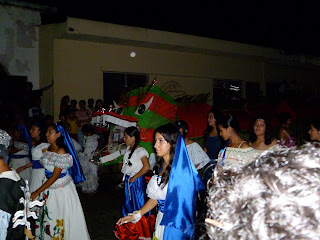Now that the feast of Santa Lucia has been duly celebrated, we are beginning the celebrations of Navidad in Suchitoto. For the last two nights, Korla and I have joined the community for Las Posadas, part drama, part pilgrimage, and part celebration. For Las Posadas, we gather at the house that was the destination on the previous evening, and all walk together with the priests, singing Christmas carols, carrying candles (which mostly blow out in the December winds) and blowing on pitos (little ceramic whistles which make quite a piercing shriek) to the next house, in another neighborhood. When we get there, the door is opened just a crack, and a long sung drama begins. On behalf of Mary and Joseph (represented by children, along with shepherds and angels), the priest asks for shelter. Those inside sing in reply, first denying entry - and this goes on, back and forth, for quite a while - but finally the "innkeepers" relent and open the door. Mary, Joseph, shepherds, angels, all of us pour in to see the Christmas tree and the
nacimiento, and our hosts bring out hot chocolate and cookies.
I'm trying to catch on to the words of the Christmas carols here - some, of course, have familiar tunes, like Silent Night and the Little Drummer Boy. I remember a few from last year, among them my favorite,
La Virgen está lavando. As best I understand it, this song tells about the Virgin washing Jesus' diapers in the river and hanging them up on a rosemary shrub while the angels are singing and the rosemary blooms. And the chorus says:
Pero mira como beben los peces en el río
mira como beben por ver a Dios nacido.
Beben y beben y vuelven a beber,
los peces en el río por ver a Dios nacer.
But look how the fish in the river are drinking,
looking how they're drinking to see God newborn.
They drink and they drink and they keep on drinking,
the fish in the river, to see God being born.
Think for a minute about those diapers being washed in the river, and what are the fish drinking with such ecstasy? What a marvellous, and very Latino, image of the fullness of the incarnation.
¡Beben y beben y vuelven a beber!


















































